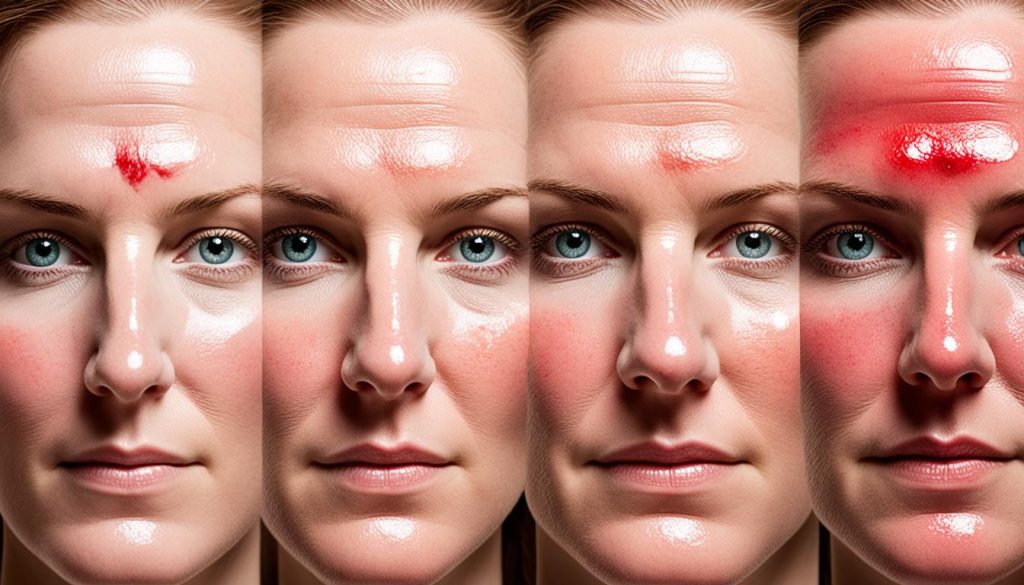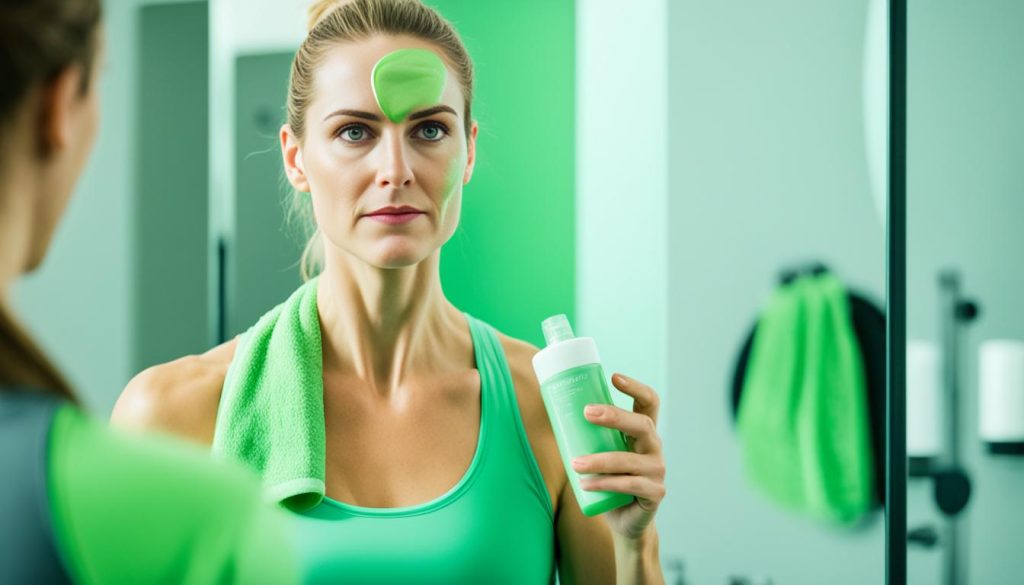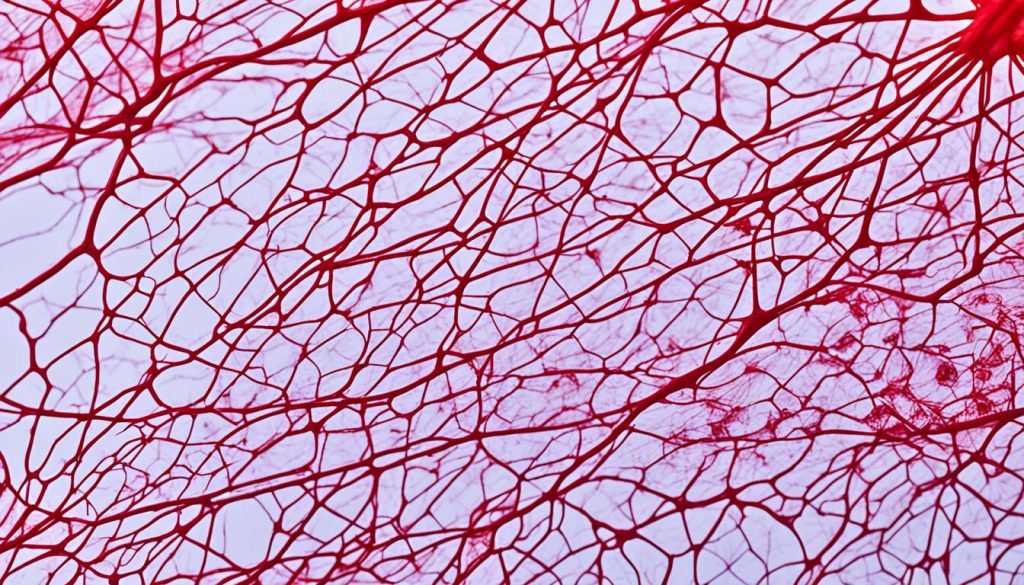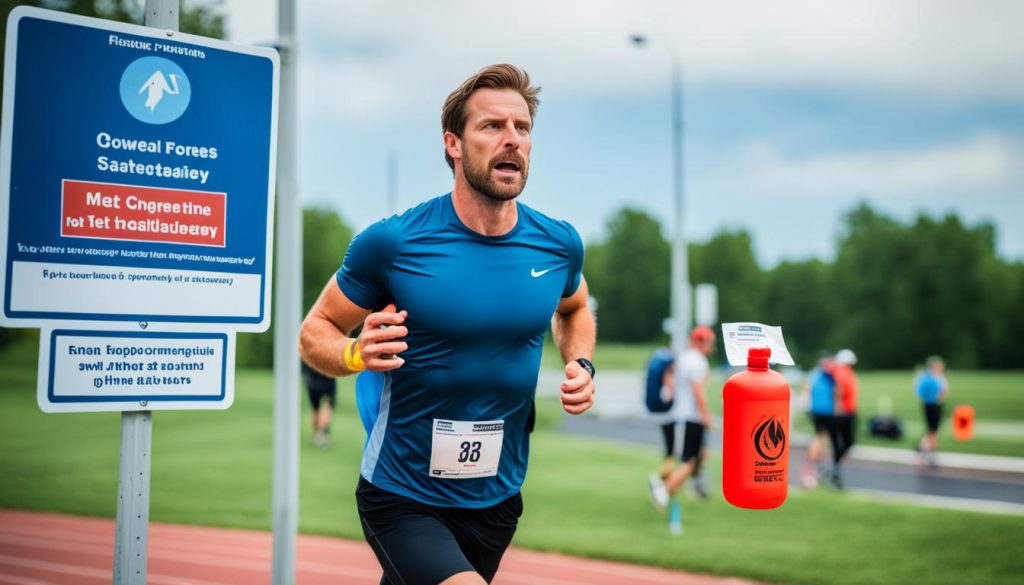If you’ve ever experienced facial redness during or after a run, you’re not alone. Many people wonder why their face turns red when they exercise, especially during intense workouts. In this article, we’ll explore the reasons behind facial redness and how you can manage it.
Facial redness during exercise, often referred to as “red cheeks when running” or “facial redness when working out,” is a common phenomenon that occurs due to the dilation of blood vessels in the face. As you engage in physical activity, your body temperature rises, prompting the blood vessels in your skin to expand. This expansion is your body’s way of releasing heat and providing more oxygen-rich blood to the muscles.
The intensity of your workout, genetics, skin type, and environmental conditions can all play a role in the degree of facial redness you experience. Fair-skinned individuals, for example, may have more noticeable redness due to their lower melanin levels. Additionally, conditions like rosacea can cause persistent facial redness, which may be further amplified during exercise.
Facial redness typically lasts for a short period, ranging from a few minutes to an hour, after your workout. Although it may be temporary, some people find it bothersome or worry that it signifies an underlying issue. In the following sections, we’ll delve deeper into the science behind facial redness, factors that can affect its intensity, and tips for managing and reducing facial redness when exercising.
To gain a better understanding of why your face gets red during a run, let’s explore the scientific explanations behind this phenomenon. Stay tuned!
Why Does My Face Get So Red When I Run?
Facial redness during exercise is primarily caused by the dilation of blood vessels in the face. When we exercise, our body temperature rises, and the blood vessels in the skin dilate to release heat and deliver oxygen to the muscles. This increased blood flow to the face gives it a red appearance. The intensity of the exercise can also impact the degree of facial redness. Certain types of exercise, like hot yoga or intense cardio, may cause more pronounced redness.
If we look at the science behind facial redness during exercise, it all comes down to facial blood flow. When we engage in physical activity, our body temperature rises, and our blood vessels start dilating to release heat. This dilation, known as vasodilation, allows for increased blood flow to the muscles, providing oxygen and nutrients needed for optimal performance. However, the blood vessels in our face also dilate, resulting in a reddened complexion.
This phenomenon occurs due to the body’s attempt to regulate temperature during exercise. As we exert ourselves, our muscles generate heat, and the dilation of blood vessels in the face helps to dissipate that heat and cool the body down. The increased blood flow also aids in supplying oxygen and nutrients to the working muscles, enhancing their performance.
The intensity of the exercise plays a role in determining the extent of facial redness. High-intensity workouts or activities that involve prolonged periods of exertion can lead to more noticeable facial redness due to increased blood flow and higher body temperature. On the other hand, moderate exercises may result in mild or less visible redness.
Factors Affecting Facial Redness
Several factors contribute to the extent of facial redness during exercise. Genetics, skin type, and the intensity of the workout play significant roles in determining the level of r edness experienced.
Individuals with more reactive blood vessels, often influenced by genetics, may be more prone to facial redness during physical activity. For those with conditions like rosacea, which causes frequent flushing or blushing, exercise can exacerbate facial redness. Furthermore, fair-skinned individuals with lower levels of melanin are more susceptible to noticeable redness due to their skin type.
The type and intensity of exercise can also affect facial redness. Activities such as hot yoga, exercises with inversions, and intense cardio workouts can trigger more pronounced redness in the face. These types of exercises cause additional blood flow to the facial area, leading to heightened redness.

It is essential to understand these factors as they can help individuals manage and minimize facial redness during exercise effectively.
Tips for Managing Facial Redness
Facial redness during exercise is usually a normal occurrence, but there are steps you can take to manage it effectively. Here are some tips:
1. Apply a cool compress:
After your workout, gently apply a cool compress to your face. The cool temperature helps constrict blood vessels and reduce redness.
2. Use a moisturizer for sensitive skin
Look for a moisturizer specifically designed to address sensitivity and facial redness. These products often contain soothing ingredients like chamomile or aloe vera that can help calm and reduce redness.
3. Consider over-the-counter products
There are over-the-counter creams and serums available that can provide temporary relief from facial redness. Look for products containing ingredients like niacinamide or green tea extract, which have anti-inflammatory properties.
4. Consult a dermatologist
If facial redness persists or is accompanied by other symptoms, it is advisable to consult a dermatologist. They can evaluate your condition and recommend suitable treatments. In some cases, prescription medications or procedures like lasers or Botox may be suggested to manage underlying conditions like rosacea.
5. Exercise in cooler environments
If you find that your face becomes excessively red during exercise, consider choosing cooler environments for your workouts. Opting for air-conditioned gyms or exercising outdoors during cooler times of the day can help reduce the intensity of facial redness.
6. Stay hydrated
Drinking plenty of water before, during, and after your workout is essential. Adequate hydration not only helps regulate body temperature but also ensures proper blood circulation, which can minimize facial redness.
7. Avoid triggers
Avoid exercising in intense heat or humid environments, as these conditions can exacerbate facial redness. Additionally, certain foods and drinks, like spicy foods or alcohol, can trigger facial flushing. Pay attention to how your body reacts to different stimuli and make adjustments accordingly.
By implementing these tips, you can effectively manage and reduce facial redness when working out or running, promoting a more comfortable and confident exercise experience.

| Tips for Managing Facial Redness |
|---|
| Apply a cool compress |
| Use a moisturizer for sensitive skin |
| Consider over-the-counter products |
| Consult a dermatologist |
| Exercise in cooler environments |
| Stay hydrated |
| Avoid triggers |
Understanding Exercise-Induced Redness
Exercise-induced redness is a natural response to increased blood flow during physical activity. As the body temperature rises, blood vessels in the skin dilate to release heat and supply oxygen to the muscles. This dilation causes the face to appear red. The degree of redness can vary based on factors such as genetics, skin type, and exercise intensity. While exercise-induced redness is usually harmless, it is important to pay attention to any accompanying symptoms like fatigue, dizziness, or excessive sweating, as these may indicate heat exhaustion or heat stroke.
During exercise, the body’s demand for oxygen and nutrients increases, leading to a dilation of blood vessels to ensure an adequate supply to the muscles and other organs involved in physical exertion. The increased blood flow causes the skin to flush, resulting in a reddish appearance. This process is known as vasodilation.
Genetics play a significant role in the extent of facial redness experienced during exercise. Certain individuals have naturally more reactive blood vessels, making their faces appear redder compared to others. Skin type also plays a part, with fair-skinned individuals being more prone to noticeable redness due to lower levels of melanin, the pigment that provides some protection against the sun’s damaging rays.
In addition to genetics and skin type, exercise intensity is another factor that contributes to facial redness. Higher-intensity exercises typically result in more pronounced redness due to the greater demand for oxygen and the subsequent increased blood flow to the muscles.
It is essential to be aware of any potential signs of heat exhaustion or heat stroke during exercise-induced redness. While redness alone is usually harmless, excessive sweating, dizziness, fatigue, and a rapid heartbeat could indicate heat-related conditions that require immediate attention. If these symptoms occur, it is crucial to stop exercising, move to a cooler environment, hydrate, and seek medical assistance if necessary.

| Factors | Contribution to Facial Redness |
|---|---|
| Genetics | Influence the reactivity of blood vessels and can make facial redness more noticeable |
| Skin Type | Fair-skinned individuals, with lower levels of melanin, are more prone to visible redness |
| Exercise Intensity | Higher-intensity exercises lead to increased blood flow and more pronounced facial redness |
Preventing and Managing Facial Redness
While it may be challenging to completely prevent facial redness during exercise, there are steps you can take to manage and minimize it.
Here are some effective strategies to help you prevent a red face during exercise and protect yourself from heat-related conditions:
- Choose cooler environments: Exercising in cooler environments or near a fan can help reduce the intensity of facial redness. Opt for air-conditioned gyms, shaded areas, or well-ventilated spaces.
- Stay hydrated: Proper hydration is crucial to prevent heat exhaustion and minimize facial redness. Drink water before, during, and after exercise to maintain optimal hydration levels.
- Avoid extreme heat: Intense exercise in extreme heat can exacerbate facial redness and increase the risk of heat-related conditions. Choose cooler times of the day or opt for indoor workouts when temperatures are high.
- Utilize cool mist spray: People with sensitive skin may benefit from using a cool mist spray during exercise. Spraying a fine mist on the face can help keep the skin cool and reduce redness.
- Pay attention to your diet: Certain foods and drinks can trigger the release of histamine and lead to facial flushing. Before workouts, avoid consuming alcohol, spicy foods, and hot beverages that may contribute to increased facial redness.
Preventing Heat Exhaustion During Exercise
Heat exhaustion is a serious condition that can occur during exercise, especially in hot and humid conditions. Here are some additional tips specifically aimed at preventing heat exhaustion:
- Know the signs: Familiarize yourself with the symptoms of heat exhaustion, such as excessive sweating, dizziness, nausea, confusion, and weakness. If you experience any of these signs, it’s crucial to stop exercising, rest, hydrate, and seek medical attention if necessary.
- Avoid intense exercise in extreme weather: When temperatures are high, choose less strenuous activities or reduce the intensity of your workout to prevent overheating.
- Wear appropriate clothing: Opt for lightweight, breathable, and moisture-wicking fabrics that allow sweat to evaporate and keep you cool during exercise. Avoid wearing tight or restrictive clothing that can hinder proper heat dissipation.
- Take breaks and rest: Listen to your body and take regular breaks during exercise, especially in hot conditions. Resting allows your body to cool down and reduces the risk of heat exhaustion.

| Prevention Strategies | Benefits |
|---|---|
| Exercising in cooler environments or near a fan | Reduces facial redness intensity |
| Staying hydrated | Prevents heat exhaustion |
| Avoiding extreme heat | Minimizes facial redness and heat-related risks |
| Utilizing cool mist spray | Keeps the skin cool and decreases redness |
| Paying attention to your diet | Reduces histamine release and facial flushing |
Conclusion
Facial redness during exercise is a normal physiological response caused by the dilation of blood vessels in the face. This natural phenomenon helps cool down the body and deliver more oxygen to the muscles for recovery and repair. While the degree of facial redness can vary based on factors such as genetics, skin type, and exercise intensity, it is typically temporary and harmless.
If you experience persistent or prolonged facial redness after a workout, or if it is accompanied by other symptoms, it is advisable to consult with a dermatologist. They can provide personalized recommendations and treatments to manage any underlying conditions like rosacea.
To minimize facial redness after exercise, remember to stay properly hydrated, especially during intense workouts. Exercising in cooler environments or near a fan can also help reduce the intensity of redness. Additionally, using soothing skincare products specifically designed to address sensitivity and redness can provide relief and promote skin recovery.
By taking these steps and seeking professional guidance when necessary, you can effectively manage facial redness and ensure a more comfortable and enjoyable exercise experience.




